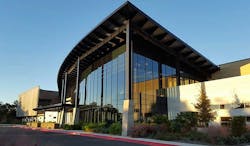The cloud computing arms race is accelerating, and the battle will be waged with data centers. The leading players are moving quickly to amass the capacity they will need for the clouds to come, resulting in huge deals for data center space under development.
Microsoft has signed massive leases for data center space in three key markets, according to a new report from a leading data center real estate specialist. The company has reserved 47 megawatts of space with deals in northern Virginia, Silicon Valley and San Antonio, which will enable Microsoft to quickly ramp up its cloud operations to meet demand.
Microsoft’s leasing, which includes several of the largest deals in the history of the data center industry, was highlighted in a new report from Jim Kerrigan of North American Data Centers, who tracks wholesale inventory across the U.S.
Kerrigan reports Microsoft has signed two leases with CyrusOne – including a massive 22 megawatt deal for space in Sterling, Va. and a 9-megawatt lease in a San Antonio – and is also the tenant in a 16 megawatt lease with DuPont Fabros Technology in Santa Clara, Ca.
Microsoft’s MegaCloud
The deals highlight how Microsoft is both building and buying infrastructure to support the rapid growth of its cloud business, sometimes in the same market. That’s the case in San Antonio, where Microsoft operates a huge company-built data center but is also reportedly leasing space from CyrusOne, which recently completed its 196,000 square foot San Antonio II facility.
Neither Microsoft nor its service providers have confirmed the recent leases. But the expansion is consistent with Microsoft’s public discussion of its cloud ambitions, and will help the company keep pace with its chief rivals in the fast-growing public cloud, which provides instant capacity for companies to run applications in other companies’ data centers.
“We operate over a million servers in data centers all over the world,” said Mark Russinovich, the Chief Technical Officer for the Microsoft Azure cloud platform, in his keynote at the recent Open Compute Summit. “Azure’s footprint operates in 22 regions. We’ve got six more coming online this year, and many more will be coming in the future.”
Cloud Building Boom
The rapid growth of cloud computing has spurred a building boom for the major Internet platforms, as Google, Microsoft, Amazon and Facebook are all super-sizing their cloud campuses to add data center capacity. Meanwhile, developers of third-party data center space are also scaling up their operations so they can lease space to cloud builders.
The rapid procurement of data center space by Microsoft follows last month’s announcement that Google is ramping up its data center capacity, with plans to add 12 new compute regions for Google Cloud Platform over the next year.
Both Microsoft and Google need cloud capacity as they seek to keep pace with market leader Amazon Web Services (AWS), which has built a massive cloud infrastructure to support its growth. That includes a large cluster of data centers in northern Virginia, where it is estimated to have a capacity of about 500 megawatts of power to support servers and storage.
Amazon is building new capacity in several sites in northern Virginia, including “Data Center Alley” in Ashburn as well as further west in the Manassas area.
The Cloud in the Fog: Amazon Web Services data centers on a rainy day in northern Virginia, where Amazon houses much of its cloud infrastructure. (Photo: Rich Miller)
Last week Amazon CEO Jeff Bezos said that AWS will become a $10 billion business this year. In a letter to shareholders, Bezos said AWS has 33 Availability Zones across 12 geographic regions worldwide, and will add another five regions and 11 Availability Zones in the coming year.
Regions are becoming more important for global cloud growth, as surveillance controversies have sharpened the focus on data sovereignty and customer privacy. As more countries seek to keep citizens’ data within their borders, cloud providers are adding data centers in these markets to accommodate these demands.
“The number of region for Azure is more than the number of region for AWS and Google,” said Kushagra Vaid, the General Manager for Azure Cloud Hardware Engingeering. “We view this global presence as a differentiator.”
How Open Compute Powers the Azure Cloud
At the Open Compute Sumit, Vaid noted that the servers now being deployed in the Azure cloud are based on Open Compute Server (OCS) designs, which Microsoft contributed when it joined the Open Compute Project in 2014.
“This is what’s powering Microsoft’s cloud,” said Vaid. “Over 90 percent of what we deploy today is based on this OCS design. We see this as a very key part of a broad ecosystem that takes the experience of a major cloud provider and applies it to the enterprise.”
Microsoft has more than a million servers in 22 regions around the globe, Microsoft Azure CTO Mark Russinovich told attendees at the Open Compute Summit last March. (Photo: Rich Miller)
Indeed, when Microsoft looks at Open Compute, it sees the enterprise. The key benefit, Vaid said, is that opening its designs makes it easier for customers using Azure for their public cloud presence to use identical infrastructure in their corporate data centers, making it easier to create hybrid infrastructures that can seamlessly move data and apps between private clouds and the public Azure platform.
“We get to tap into a larger supply ecosystem,” said Vaid. “Our enterprise customers tell us ‘we want to use what you’re using,'” he said. “We take our customers to Quincy (Washington) and tour them through our data center. They say ‘this is fantastic. I just want to buy what you’re buying.’ ”
They can now introduce those customers to vendors who support Microsoft’s Open Compute Server. “Organizations of all sizes can take advantage of our innovations in order to improve the performance, efficiency, power consumption and costs of their data centers,” said Russinovich.
Good News for Data Center Builders
The robust leasing activity by Microsoft demonstrates how the growth of cloud computing is providing a huge boost for data center developers. It’s long been expected that cloud business models would eventually impact the market for on-premises data center space, especially smaller server closets. But cloud growth is now driving phenomenal demand for additional “plug-n-play” data center capacity, a trend that could continue for some time to come.
“Large blocks of built-out space will be key as cloud providers attempt to gain market share by taking down existing MTDC (multi-tenant data center space),” Kerrigan wrote in his latest market report.
The focal point for that demand is northern Virginia, which has seen vigorous demand for space. “The relatively low costs for space and power, coupled with the unique density of carriers, content providers, and cloud firms, have driven demand for data centers in the area and will continue to do so,” said Kerrigan, who noted that the state of Virginia recently extended data center incentives that will provide significant tax breaks on servers and software through 2035.






